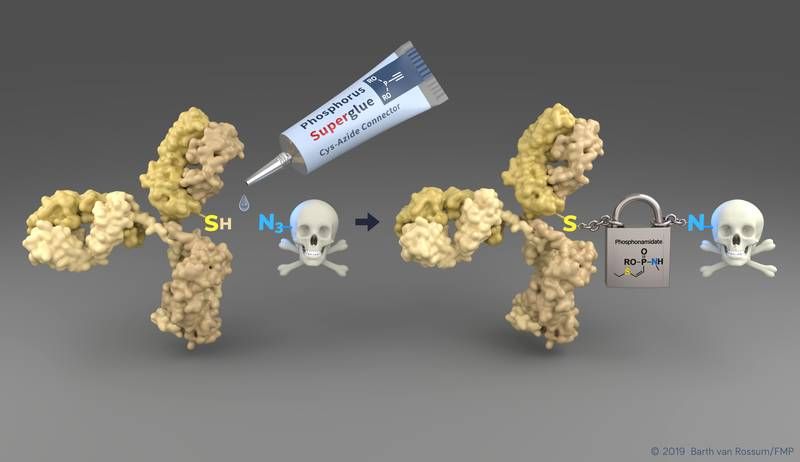Bringing cancer medication safely to its destination
Treating cancer more selectively and more effectively – this could be achieved with an innovative technology developed by teams of researchers at the Leibniz-Forschungsinstitut für Molekulare Pharmakologie (FMP) and the Ludwig-Maximilians-Universität München (LMU). The process transforms proteins and antibodies into stable, highly functional drug transporters, with which tumor cells can be detected and killed.

The new technology enables a simple way of connecting the cytsteine residues (SH) of a tumor-sensing antibody (yellow) to toxic drug molecules. The emerging linker is highly stable during blood circulation and enables therefore a safe transport to the tumor side.
Barth van Rossum (FMP)
Classic chemotherapy for the treatment of cancer is based on toxic substances that are particularly effective for rapidly dividing cells. However, since healthy tissue also depends on cell division, treatment with chemotherapeutic substances is often accompanied by severe side effects. A dose sufficient to completely remove the tumor, would in many cases be too toxic to administer to a diseased person. With more modern approaches, it is now possible to transport active agents (drugs) in the body selectively to the site of action, for example by linking a drug with an antibody that can differentiate cancer cells from healthy tissue through changes on the surface of the cell. Five such Antibody Drug Conjugates (ADCs) are already on the market.
However, these ADCs lose a large part of their "toxic cargo" en route to the cancer cell. The substances (drugs) are released into the bloodstream and dangerous side effects can occur. A stable link between drug and antibody would therefore be highly desirable. This is precisely what the researchers – a team led by Professor Christian Hackenberger from the FMP and Professor Heinrich Leonhardt from the LMU Biocenter – focused on. Their results have been published in the journal, Angewandte Chemie: In two consecutive articles, the development of methods and the application of these methods to selective drug transport are presented.
The new drug transporters enable lower doses and less severe side effects
"We have developed an innovative technology that makes it possible to link native proteins and antibodies to complex molecules, such as fluorescent dyes or drugs more easily and with better stability than ever before," reports Marc-André Kasper, a researcher in Christian Hackenberger's group. The researchers discovered the outstanding properties of unsaturated phosphorus (V) compounds and took advantage of those. These phosphonamidates connect a desired modification – for example, a cancer-fighting agent – exclusively to the amino acid cysteine, in a protein or antibody. Since cysteine is a very rare natural occurring amino acid, the number of modifications per protein can be controlled quite effectively, which is essential for the construction of drug conjugates. In addition, phosphonamidates can easily be incorporated into complex chemical compounds. "The greatest achievement of the new method, however, is that the resulting bond is also stable during blood circulation," says Marc-André Kasper. The ADCs that are on the market cannot achieve this.
To test the applicability on targeted drug delivery, the researchers compared their technology directly with the FDA-approved ADC, Adcetris®. The medication was re-created as precisely as possible with the same antibody and active agent, the only difference was that the innovative phosphonamidate linkage was used. When applied to blood serum, the researchers observed that their modified ADC lost significantly less active ingredient over a period of days. They also used the new technology in experiments with mice to combat Hodgkin's lymphoma. The preparation proved to be more effective than the conventional medication. "From our results, we conclude that phosphonamidate-linked drug transporters can be administered in lower doses, and that side effects can be further reduced. Thus the technology has great potential to replace current methods in order to develop more effective and safer ADCs in the future," says FMP group leader Christian Hackenberger.
In the next step, the research groups will continue their efforts in the development of ADCs based on phosphonamidates. Preclinical studies, which are essential for the treatment of patients, are already underway. In this regard, the promising start-up company Tubulis, which was awarded the Leibniz Start-Up Prize last year, functions as a platform for the further development to market maturity.
Original publication
Marc-André Kasper, Maria Glanz, Andreas Stengl, Martin Penkert, Simon Klenk, Tom Sauer, Dominik Schumacher, Jonas Helma, Eberhard Krause, M. Cristina Cardoso, Heinrich Leonhardt, Christian P. R. Hackenberger; "Cysteine‐Selective Phosphonamidate Electrophiles for Modular Protein Bioconjugations"; Angew. Chem. Int. Ed.; 2019
Marc-André Kasper, Andreas Stengl, Philipp Ochtrop, Marcus Gerlach, Tina Stoschek, Dominik Schumacher, Jonas Helma, Martin Penkert, Eberhard Krause, Heinrich Leonhardt, Christian P. R. Hackenberger; "Ethynylphosphonamidates for the rapid and cysteine selective generation of efficacious Antibody-Drug-Conjugates"; Angew. Chem. Int. Ed.; 2019
Other news from the department science
Most read news
More news from our other portals
Something is happening in the life science industry ...
This is what true pioneering spirit looks like: Plenty of innovative start-ups are bringing fresh ideas, lifeblood and entrepreneurial spirit to change tomorrow's world for the better. Immerse yourself in the world of these young companies and take the opportunity to get in touch with the founders.






















































